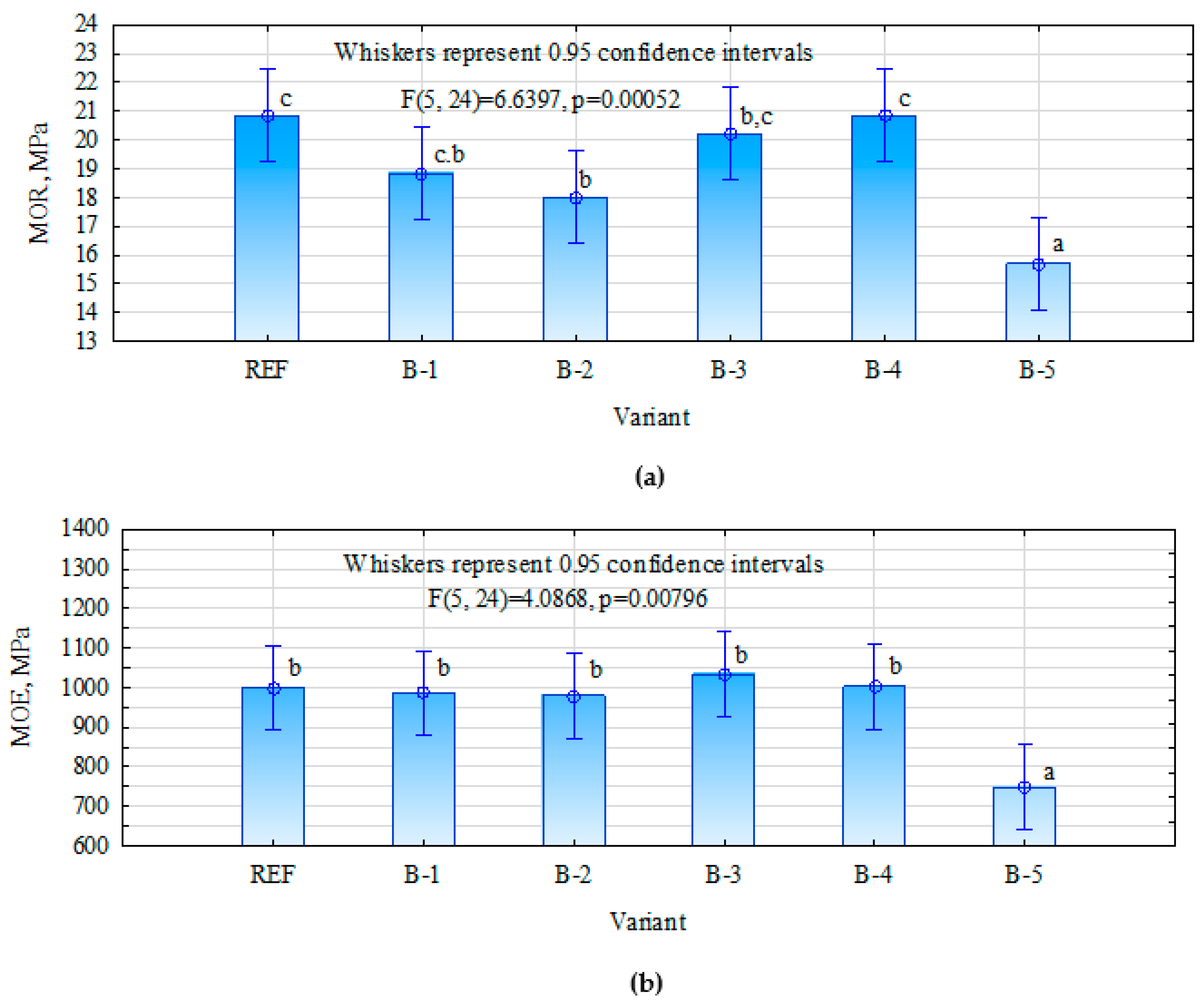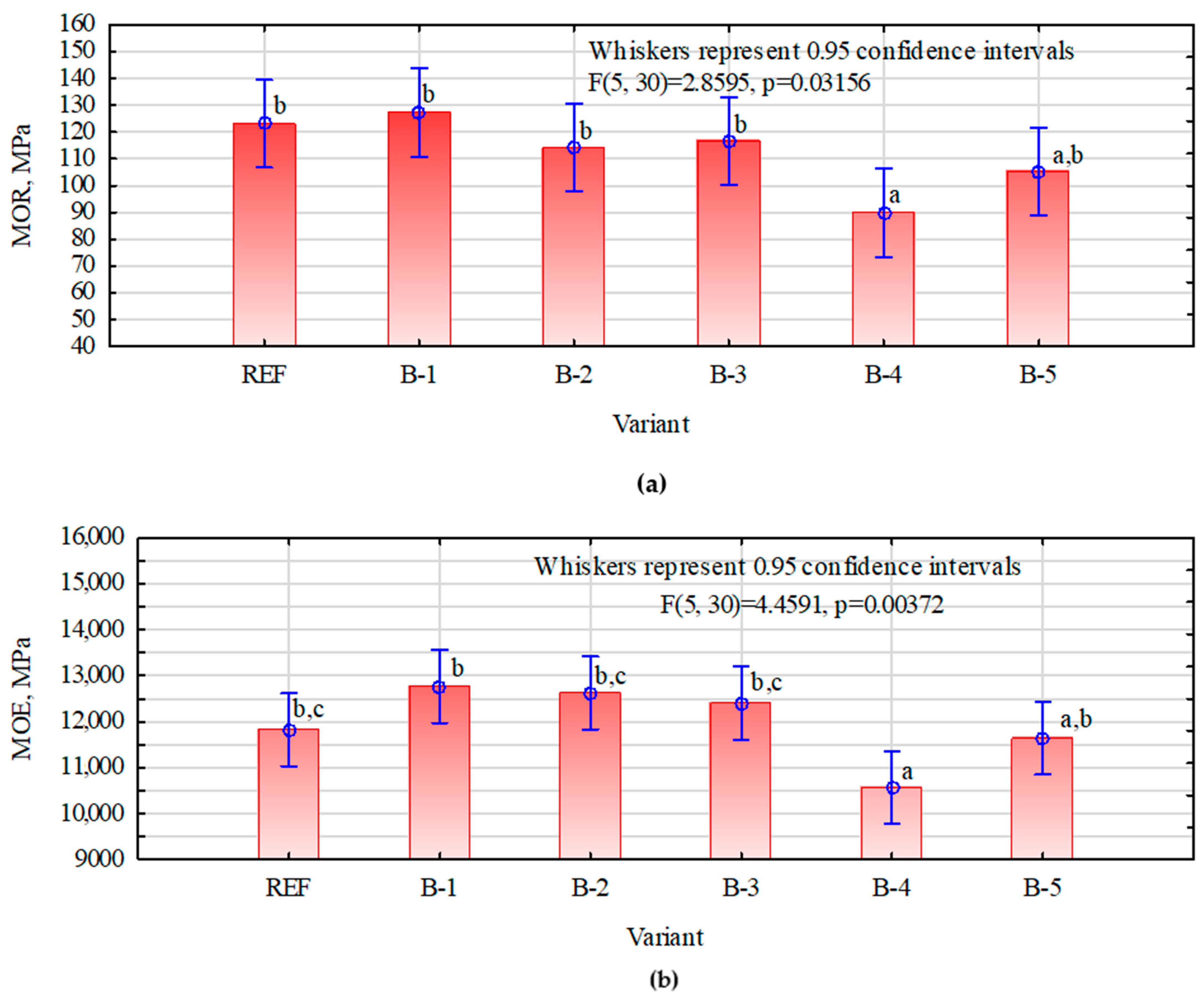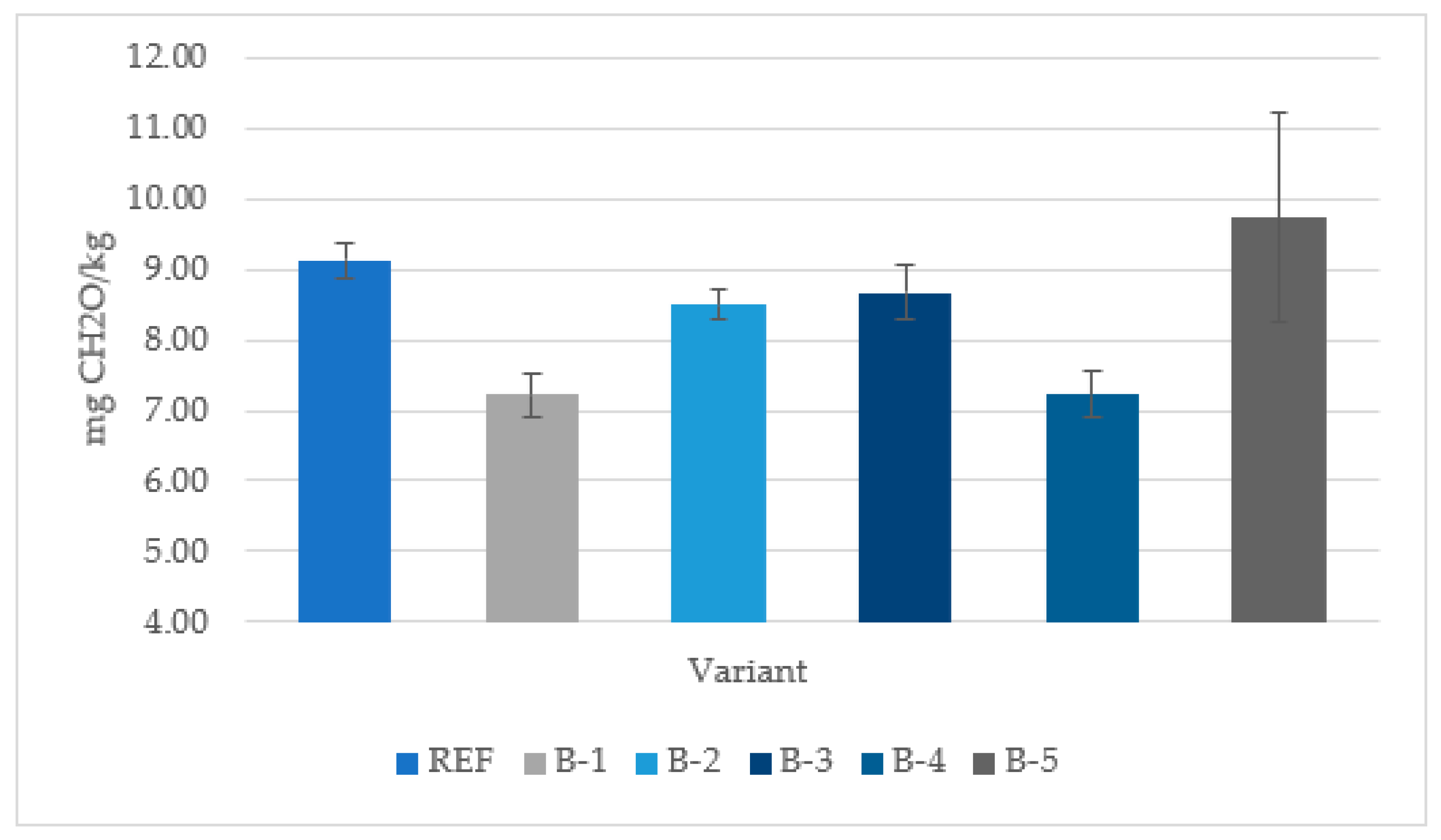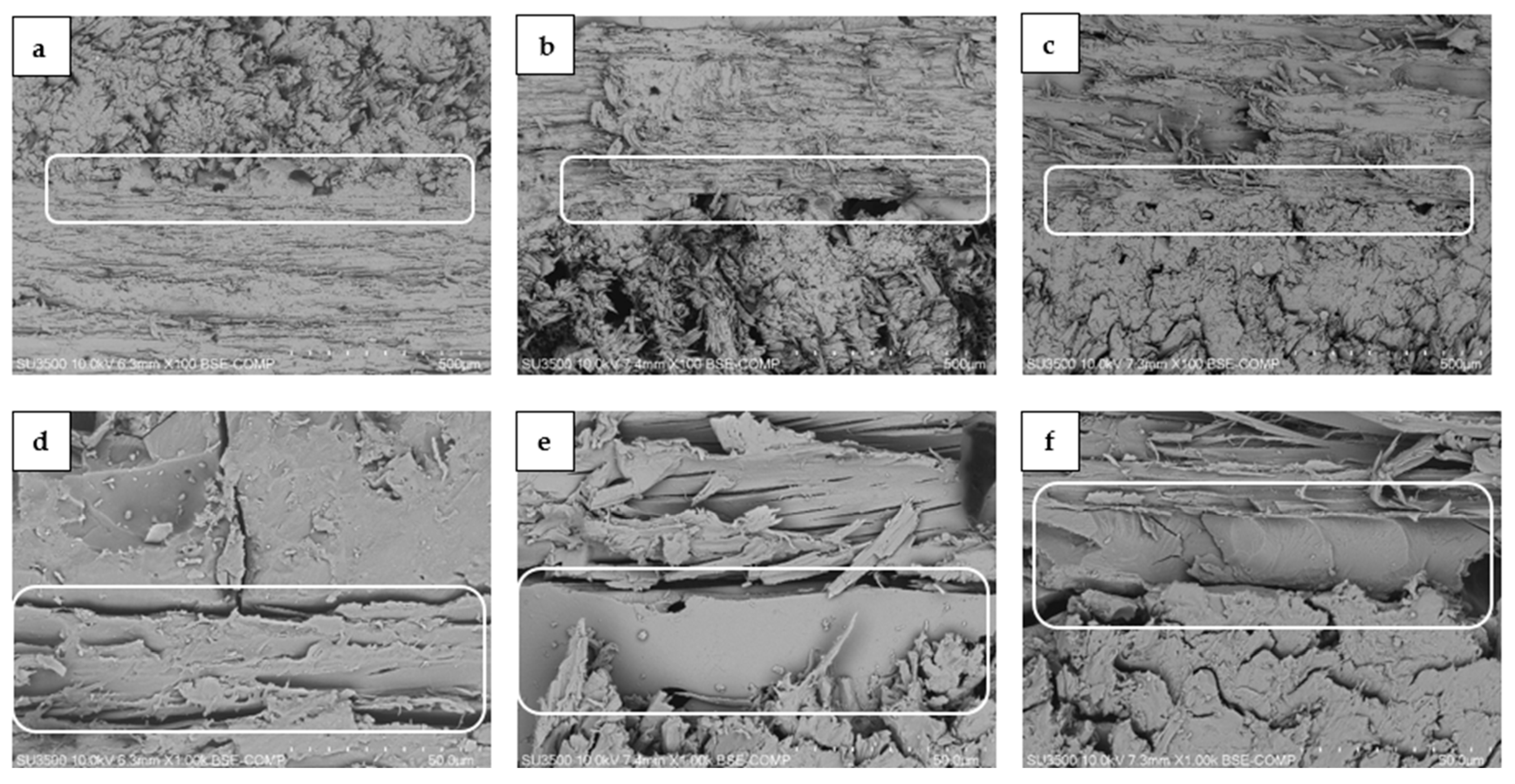The Application of Various Bark Species as a Fillers for UF Resin in Plywood Manufacturing
Abstract
:1. Introduction
2. Materials and Methods
2.1. Materials
2.2. Methods
3. Results
3.1. Tensile Strength
3.2. Modulus of Elasticity (MOE) and Bending Strength (MOR)
3.3. Formaldehyde Emission
3.4. SEM Analysis
4. Conclusions
Author Contributions
Funding
Institutional Review Board Statement
Informed Consent Statement
Data Availability Statement
Conflicts of Interest
References
- Kawalerczyk, J.; Dziurka, D.; Mirski, R.; Trociński, A. Flour Fillers with Urea-Formaldehyde Resin in Plywood. BioResources 2019, 14, 6727–6735. [Google Scholar] [CrossRef]
- Bekhta, P.; Sedliačik, J.; Kačík, F.; Noshchenko, G.; Kleinová, A. Lignocellulosic Waste Fibers and Their Application as a Component of Urea-Formaldehyde Adhesive Composition in the Manufacture of Plywood. Eur. J. Wood Wood Prod. 2019, 77, 495–508. [Google Scholar] [CrossRef]
- Dukarska, D.; Czarnecki, R. Fumed Silica as a Filler for MUPF Resin in the Process of Manufacturing Water-Resistant Plywood. Eur. J. Wood Wood Prod. 2016, 74, 5–14. [Google Scholar] [CrossRef] [Green Version]
- Sellers, T.; Miller, G.D.; Smith, W. Tool Wear Properties of Five Extender/Fillers in Adhesive Mixes for Plywood. For. Prod. J. 2005, 55, 27–31. [Google Scholar]
- Cichy, W. Combustion of Plywood Waste in a Low-Power Boiler. Drew. Pr. Nauk. Doniesienia Komun. 2012, 55, 21–36. [Google Scholar]
- Pasztory, Z.; Mohácsiné, I.R.; Gorbacheva, G.; Börcsök, Z. The Utilization of Tree Bark. BioResources 2016, 11, 7859–7888. [Google Scholar] [CrossRef]
- Blanco-García, A.; Lindig-Cisneros, R. Incorporating Restoration in Sustainable Forestry Management: Using Pine-Bark Mulch to Improve Native Species Establishment on Tephra Deposits. Restor. Ecol. 2005, 13, 703–709. [Google Scholar] [CrossRef]
- Dou, J. Willow Inner Bark as a Potential Source of Fibres and Chemicals. Master’s Thesis, Aalto University School of Chemical Technology, Espoo, Finland, 2015. [Google Scholar]
- Scalbert, A.; Monties, B.; Favre, J.-M. Polyphenols of Quercus Robur: Adult Tree and in Vitro Grown Calli and Shoots. Phytochemistry 1988, 27, 3483–3488. [Google Scholar] [CrossRef]
- Fernández de Simón, B.; Cadahía, E.; Conde, E.; García-Vallejo, M.C. Low Molecular Weight Phenolic Compounds in Spanish Oak Woods. J. Agric. Food Chem. 1996, 44, 1507–1511. [Google Scholar] [CrossRef]
- Jordão, A.M.; Ricardo-da-Silva, J.M.; Laureano, O. Ellagitannins from Portuguese Oak Wood (Quercus Pyrenaica Willd.) Used in Cooperage: Influence of Geographical Origin, Coarseness of the Grain and Toasting Level. Wood Res. Technol. Holzforsch. 2007, 61, 155–160. [Google Scholar] [CrossRef]
- Skrypnik, L.; Grigorev, N.; Michailov, D.; Antipina, M.; Danilova, M.; Pungin, A. Comparative Study on Radical Scavenging Activity and Phenolic Compounds Content in Water Bark Extracts of Alder (Alnus Glutinosa (L.) Gaertn.), Oak (Quercus Robur, L.) and Pine (Pinus Sylvestris, L.). Eur. J. Wood Wood Prod. 2019, 77, 879–890. [Google Scholar] [CrossRef]
- Kawalerczyk, J.; Siuda, J.; Mirski, R.; Dziurka, D. Hemp Flour as a Formaldehyde Scavenger for Melamine-Urea-Formaldehyde Adhesive in Plywood Production. BioResources 2020, 15, 4052–4064. [Google Scholar] [CrossRef]
- Mirski, R.; Kawalerczyk, J.; Dziurka, D.; Siuda, J.; Wieruszewski, M. The Application of Oak Bark Powder as a Filler for Melamine-Urea-Formaldehyde Adhesive in Plywood Manufacturing. Forests 2020, 11, 1249. [Google Scholar] [CrossRef]
- Mari, E.L.; Jimenez, J.; Lapuz, R.B. Spent Tea Leaves as Extender and Scavenger for Urea Formaldehyde-Bonded Plywood. Philipp. J. Sci. 2018, 147, 285–291. [Google Scholar]
- Taghiyari, H.R.; Hosseini, S.B.; Ghahri, S.; Ghofrani, M.; Papadopoulos, A.N. Formaldehyde Emission in Micron-Sized Wollastonite-Treated Plywood Bonded with Soy Flour and Urea-Formaldehyde Resin. Appl. Sci. 2020, 10, 6709. [Google Scholar] [CrossRef]
- Ong, H.R.; Prasad, D.R.; Khan, M.R.; Rao, D.S.; Nitthiyah, J.; Raman, D.K. Effect of Jatropha Seed Oil Meal and Rubber Seed Oil Meal as Melamine Urea Formaldehyde Adhesive Extender on the Bonding Strength of Plywood. J. Appl. Sci. 2012, 12, 1148–1153. [Google Scholar] [CrossRef] [Green Version]
- Ong, H.R.; Prasad, R.; Rahman Khan, M.; Chowdhury, M.; Kabir, N. Effect of Palm Kernel Meal as Melamine Urea Formaldehyde Adhesive Extender for Plywood Application: Using a Fourier Transform Infrared Spectroscopy (FTIR) Study. In Proceedings of the Applied Mechanics and Materials; Trans Tech Publications Ltd: Bach, Switzerland, 2012; Volume 121, pp. 493–498. [Google Scholar]
- Ong, H.R.; Khan, M.M.R.; Prasad, D.R.; Yousuf, A.; Chowdhury, M.N.K. Palm Kernel Meal as a Melamine Urea Formaldehyde Adhesive Filler for Plywood Applications. Int. J. Adhes. Adhes. 2018, 85, 8–14. [Google Scholar] [CrossRef]
- Tudor, E.M.; Barbu, M.C.; Petutschnigg, A.; Réh, R.; Krišt’ák, L. Analysis of Larch-Bark Capacity for Formaldehyde Removal in Wood Adhesives. Int. J. Environ. Res. Public Health 2020, 17, 764. [Google Scholar] [CrossRef] [PubMed] [Green Version]
- Medved, S.; Gajsek, U.; Tudor, E.M.; Barbu, M.C.; Antonovic, A. Efficiency of Bark for Reduction of Formaldehyde Emission from Particleboards. Wood Res. 2019, 64, 307–315. [Google Scholar]
- Turgut Sahin, H.; Burak Arslan, M. Weathering Performance of Particleboards Manufactured from Blends of Forest Residues with Red Pine (Pinus Brutia) Wood. Maderas. Cienc. Tecnol. 2011, 13, 337–346. [Google Scholar] [CrossRef]
- Réh, R.; Igaz, R.; Krišt’ák, L.; Ružiak, I.; Gajtanska, M.; Božíková, M.; Kučerka, M. Functionality of Beech Bark in Adhesive Mixtures Used in Plywood and Its Effect on the Stability Associated with Material Systems. Materials 2019, 12, 1298. [Google Scholar] [CrossRef] [PubMed] [Green Version]
- Ružiak, I.; Igaz, R.; Krišt’ák, L.; Réh, R.; Mitterpach, J.; Očkajová, A.; Kučerka, M. Influence of Urea-Formaldehyde Adhesive Modification with Beech Bark on Chosen Properties of Plywood. BioResources 2017, 12, 3250–3264. [Google Scholar] [CrossRef] [Green Version]
- Aydin, I.; Demirkir, C.; Colak, S.; Colakoglu, G. Utilization of Bark Flours as Additive in Plywood Manufacturing. Eur. J. Wood Wood Prod. 2017, 75, 63–69. [Google Scholar] [CrossRef]
- Mirski, R.; Kawalerczyk, J.; Dziurka, D.; Wieruszewski, M.; Trociński, A. Effects of Using Bark Particles with Various Dimensions as a Filler for Urea-Formaldehyde Resin in Plywood. BioResources 2020, 15, 1692–1701. [Google Scholar]
- EN 322; Wood-Based Panels-Determination of Moisture Content. European Committee for Standardization: Brussels, Belgium, 1996.
- EN 314-1; Plywood–Bond Quality–Test Methods. European Committee for Standardization: Brussels, Belgium, 2004.
- EN 310; Wood-Based Panels–Determination of Modulus of Elasticity in Bending and of Bending Strength. European Committee for Standardization: Brussels, Belgium, 1994.
- EN 717-3; Wood-Based Panels–Determination of Formaldehyde Release–Part 3: Formaldehyde Release by the Flask Method. European Committee for Standardization: Brussels, Belgium, 1996.
- Elbadawi, M.; Osman, Z.; Paridah, T.; Nasroun, T.; Kantiner, W. Mechanical and Physical Properties of Particleboards Made from Ailanthus Wood and UF Resin Fortified by Acacias Tannins Blend. J. Mater. Environ. Sci. 2015, 6, 1016–1021. [Google Scholar]
- Xing, C.; Zhang, S.Y.; Deng, J.; Wang, S. Urea–Formaldehyde-Resin Gel Time as Affected by the PH Value, Solid Content, and Catalyst. J. Appl. Polym. Sci. 2007, 103, 1566–1569. [Google Scholar] [CrossRef]
- Nemli, G.; Kırcı, H.; Temiz, A. Influence of Impregnating Wood Particles with Mimosa Bark Extract on Some Properties of Particleboard. Ind. Crops Prod. 2004, 20, 339–344. [Google Scholar] [CrossRef]
- Wang, X.M.; Li, J.Z.; Zhang, J.Z.; Gao, Q. Technics and Properties of Plywood Manufacture with Modified Urea-Formaldehyde Resin. In Proceedings of the Advanced Materials Research; Trans Tech Publications Ltd: Bach, Swizterland, 2013; Volume 602, pp. 743–746. [Google Scholar]
- Réh, R.; Krišťák, Ľ.; Sedliačik, J.; Bekhta, P.; Božiková, M.; Kunecová, D.; Vozárová, V.; Tudor, E.M.; Antov, P.; Savov, V. Utilization of Birch Bark as an Eco-Friendly Filler in Urea-Formaldehyde Adhesives for Plywood Manufacturing. Polymers 2021, 13, 511. [Google Scholar] [CrossRef]
- Vázquez, G.; Antorrena, G.; González, J.; Alvarez, J.C. Tannin-Based Adhesives for Bonding High-Moisture Eucalyptus Veneers: Influence of Tannin Extraction and Press Conditions. Holz Als Roh Und Werkst. 1996, 54, 93–97. [Google Scholar] [CrossRef]
- Lubis, M.A.R.; Park, B.-D. Enhancing the Performance of Low Molar Ratio Urea–Formaldehyde Resin Adhesives via in-Situ Modification with Intercalated Nanoclay. J. Adhes. 2021, 97, 1271–1290. [Google Scholar] [CrossRef]
- Van Der Klashorst, G.H.; Strauss, H.F. Polymerization of Lignin Model Compounds with Formaldehyde in Acidic Aqueous Medium. J. Polym. Sci. Part A Polym. Chem. 1986, 24, 2143–2169. [Google Scholar] [CrossRef]
- Jahanshaei, S.; Tabarsa, T.; Asghari, J. Eco-Friendly Tannin-Phenol Formaldehyde Resin for Producing Wood Composites. Pigment. Resin Technol. 2012, 41, 296–301. [Google Scholar] [CrossRef]
- Kunecová, D.; Hlaváč, P. Determination of Activation Energy of the Pellets and Sawdust Using Thermal Analysis. Agron. Res. 2019, 17, 2306–2316. [Google Scholar]
- Hogger, E.M.; Van Herwijnen, H.W.; Moser, J.; Kantner, W.; Konnerth, J. Systematic Assessment of Wheat Extenders in Formaldehyde-Condensation Plywood Resins: Part II–Mechanical Properties of Plywood Panels. J. Adhes. 2021, 97, 1310–1321. [Google Scholar] [CrossRef]





| Variant Label | Type of Filler | Quantity (pwb Per 100 pwb of Solid Resin) | pH | |
|---|---|---|---|---|
| Filler | Hardener Solution | |||
| REF | Rye flour | 20 | 2 | 6.88 |
| B-1 | Birch bark | 20 | 2 | 6.57 |
| B-2 | Beech bark | 20 | 2 | 6.50 |
| B-3 | Maple bark | 20 | 2 | 6.89 |
| B-4 | Pine bark | 20 | 2 | 6.21 |
| B-5 | Spruce bark | 20 | 2 | 6.26 |
| Variant Label | Density [kg/m3] | Moisture Content [%] | Thickness [mm] |
|---|---|---|---|
| REF | 626 | 5.0 | 3.98 |
| B-1 | 689 | 5.1 | 4.04 |
| B-2 | 679 | 5.2 | 4.16 |
| B-3 | 698 | 4.8 | 3.95 |
| B-4 | 643 | 4.6 | 3.94 |
| B-5 | 602 | 5.2 | 3.92 |
Publisher’s Note: MDPI stays neutral with regard to jurisdictional claims in published maps and institutional affiliations. |
© 2022 by the authors. Licensee MDPI, Basel, Switzerland. This article is an open access article distributed under the terms and conditions of the Creative Commons Attribution (CC BY) license (https://creativecommons.org/licenses/by/4.0/).
Share and Cite
Walkiewicz, J.; Kawalerczyk, J.; Mirski, R.; Dziurka, D.; Wieruszewski, M. The Application of Various Bark Species as a Fillers for UF Resin in Plywood Manufacturing. Materials 2022, 15, 7201. https://doi.org/10.3390/ma15207201
Walkiewicz J, Kawalerczyk J, Mirski R, Dziurka D, Wieruszewski M. The Application of Various Bark Species as a Fillers for UF Resin in Plywood Manufacturing. Materials. 2022; 15(20):7201. https://doi.org/10.3390/ma15207201
Chicago/Turabian StyleWalkiewicz, Joanna, Jakub Kawalerczyk, Radosław Mirski, Dorota Dziurka, and Marek Wieruszewski. 2022. "The Application of Various Bark Species as a Fillers for UF Resin in Plywood Manufacturing" Materials 15, no. 20: 7201. https://doi.org/10.3390/ma15207201





